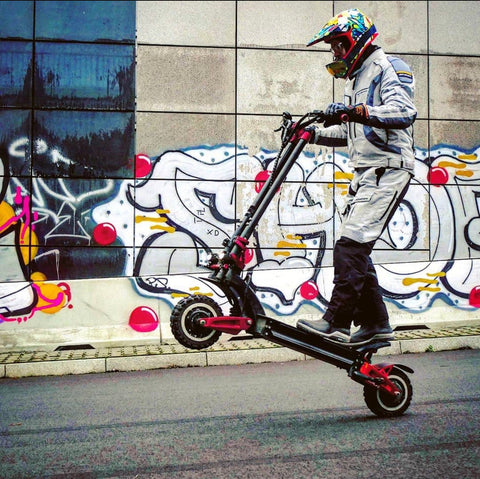How to choose an electric scooter
With so many options out there, getting an e-scooter is nowhere near straightforward
The e-scooter industry might still be in its infancy, but these electrically-powered machines are enjoying an increasing amount of popularity by the day. People living in big cities have rushed to adopt this new trend out of purely practical reasons - with so many cars stuck in traffic, e-scooters are the shortcut more, and more people are willing to take. Factor in their relatively low maintenance costs and the fact that you can easily fold them for storage or transport purposes, plus the advantage of not getting to your destination with a sweaty back, like it happens with bicycles or kick scooters, and you get an unbeatable recipe.

But with high demand comes high offer. With more and more people looking to get an e-scooter, companies that produce them have multiplied like rabbits, and others are joining them as we speak. This means that you, the buyers, now has hundreds of options to choose from, from low-end, cheap e-scooters to performance and off-road-oriented ones. So, which one is best for you? Well, only you can decide that, but we’ll give you a hand with a guide that touches on what key aspects you should consider before placing that order.
SPEED
Performance is a paramount aspect when deciding to splash the cash for a new electric scooter. However, before deciding which level of performance is the right choice for you, a few concepts must be discussed, such as speed, power, and range. Let’s take them one at a time.
Are you buying your first e-scooter? Haven’t had the chance to ride one before? Well, it that case, you might be better off with an entry-level electric scooter. These days, you can get an e-scooter that’s capable of reaching speeds of 90 mph, but do you really need it?
As we see it, around the city you’ll be just fine with an electric scooter that can pull off around 15 mph, which is already more than five times the speed you’ll reach on foot (without running, obviously).
Speed is also dictated by the type of surface at your disposal. And we all know that not every patch of asphalt is smooth around the city. But there are e-scooters which are capable of doing as much as 40+ mph. Then again, ask yourself this: is this top speed a realistic target for you? Do you want to slalom around parked cars at this speed? Of course, if you can find a safe space with smooth asphalt and zero obstacles, a 40-mph e-scooter can be fun as hell, but otherwise, you’ll never get to enjoy its full potential.

POWER
An e-scooter’s electric motor can output as low as 250W or as high as 100000W. However, most e-scooters will offer around 500W to 2000W worth of power, coming from one or two electric motors found inside the wheel or wheels. A high-power electric motor is useful when your commute route includes steeper inclines or when you travel long, straight patches of smooth asphalt with low traffic, when you’ll want to reach top speed more quickly - or a particular cruising speed that allows you to save time and get to your destination without being late.
RANGE
Range-wise, try to think about how will you use the e-scooter. Is your commute rather long? Then you might want an electric scooter that’s fitted with a larger battery. Of course, going for a bigger battery not only increases costs but also adds more weight into the mix, which is something we’ll address in the following section. However, if you plan on using the e-scooter around the park on weekends for mild strolling around, then you won’t necessarily need a long-range one.
Charging is also important here. If you’re planning to use your e-scooter on a daily basis, then go for one that charges faster (3-4 hours).
If not, you can pick one that needs a bit more time to charge, since you won’t be needing it that often anyway. Tip: when checking out e-scooter specs for range estimates, makes sure to take into account that producers bump the theoretical values by 30% compared to what you’ll get in real life. Also, range is affected by variables such as rider weight, extra load, terrain incline, surface quality, and speed.

COMFORT
It goes without saying that riding an e-scooter should also be comfortable. In essence, we mean as few vibrations and shakes as possible, no wrist pain after prolonged use, and a relaxed and anatomically correct position while riding. For that to happen, you must take a good look at the following.
WHEELS
Wheels are your connection to the ground. They provide traction, but they also help cushion the irregularities that rough terrain might throw at you. So when talking about comfort on an electric scooter, it’s paramount to discuss wheels.
Now, there are two types of wheels: air-filled wheels and solid wheels.
The former are preset on high-end e-scooters and work just like those you’ve got on a car: the air inside provides a cushion that soaks up bumps and whatnot. Air tires are better for handling, especially on wet/slippery surfaces due to their flexibility, but they do require more maintenance and are quite prone to punctures. Solid tires (or airless tires) have that rugged factor, but since there’s nothing to absorb the shocks, you’ll feel pretty much every knock and jerk unless you pick ultra-flat surfaces to ride on. On the other hand, they require virtually zero maintenance without the risk of getting a flat tire.
SUSPENSION
Once you’ve sorted out the tire choice, it’s time to focus on suspension. Now, if you pick a scooter that has air tires, a suspension system might not be a priority - or at least not a fancy one with multiple shocks, as seen on performance e-scooters. However, if you know your city has bad roads, then a combo of the two (air tires + suspension) could make all the difference in the world. Usually, manufacturers fit their e-scooters with suspension setups that focus just on one wheel or on both, with the latter variety being more expensive but also a lot more comfortable. Our advice is to get an e-scooter that offers suspension at least on one wheel.

WEIGHT & SIZE
Last but not least, finding a comfortable e-scooter for your build and frame contributes a lot to the comfort case. Just think about it: would you be able to control an e-scooter that’s too large for you? Then again, won’t it be tricky to maintain balance on an undersized electric scooter? What if your feet don’t fully fit in on the board? How will you ride? It’s the same with the e-scooter’s weight. So, again, try to think how you will use it: your building doesn’t have an elevator? Well, even if the scooter is foldable, you’ll still have to carry it to your apartment by taking the stairs. Most decent e-scooters out there tip the scales at a little over 11 kilos, but performance-oriented one can weigh up to 50+kilos or even more than that, depending on the amount of gear and components they use.
SAFETY
Yes, safety is a must when riding an e-scooter. So let’s start with brakes. They are usually fitted according to the electric scooter’s motor power and can be of various sorts: electric/regenerative, foot brakes (where you brake by pressing the rear wheel fender), drum brakes, and disc brakes.
Disc brakes are the best compromise in terms of bite power and lightness, but drum brakes are also good if you’re looking at a no-nonsense, low-maintenance brake system.
Foot brakes can also work, but since you’ll brake the rear wheel with your foot, it’s easier to lose balance and skid. Foot brakes, however, are better than electric ones, which are the weakest of the bunch. So if you’re looking for short stopping distances, look elsewhere.
Another aspect of safety has to do with the protective gear. Although this is the last thing people take into account when buying an e-scooter, a helmet, coupled with the proper knee and elbow pads, can save your life or help you avoid severe, potentially crippling injuries.

PRACTICALITY
Let’s say you commute has sections that can be covered by using public transportation. In this case, naturally, you’ll want your e-scooter to be foldable to some extent. It goes the same if you’re planning to take it on the plane - some airlines have strict e-scooter policies that don’t allow larger or heavier e-scooters onboard their planes. While most e-scooters out there offer folding capabilities, some are easier to pack while others take more steps. Balance these factors and based on where and when you’ll be using your e-scooter, try to pick the variant that works best for you.
PRICE
As a rule of the thumb, an e-scooter’s quality and level of gear improve as the price goes up. That doesn’t mean you can’t find bargains or products that offer outstanding value for money, but usually, it’s the higher-priced e-scooters that offer the best of everything in terms of range, speed, sturdiness, comfort, and safety.
To put things into perspective, a £250 electric-scooter most likely won’t deliver any of the above qualities, while an e-scooter that’s priced at, let’s say, £700- £1500 or more, is bound to be better built and assembled, as well as more equipped to satisfy your needs.
Ultimately, it would help a lot if you could test ride the thing before buying it, but that’s not what the real world teaches us. Today, you can buy one such e-scooter with just about three mouse clicks, without even seeing it, let alone taking it for a spin. But we hope this guide will prove helpful and do let us know in the comments section if we missed a point.



